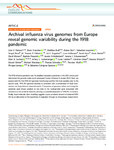2022-05-10Zeitschriftenartikel
Archival influenza virus genomes from Europe reveal genomic variability during the 1918 pandemic
Patrono, Livia V.
Vrancken, Bram
Budt, Matthias
Düx, Ariane
Lequime, Sebastian
Boral, Sengül
Gilbert, M. Thomas P.
Gogarten, Jan F.
Hoffmann, Luisa
Horst, David
Merkel, Kevin
Morens, David
Prepoint, Baptiste
Schlotterbeck, Jasmin
Schuenemann, Verena J.
Suchard, Marc A.
Taubenberger, Jeffery K.
Tenkhoff, Luisa
Urban, Christian
Widulin, Navena
Winter, Eduard
Worobey, Michael
Schnalke, Thomas
Wolff, Thorsten
Lemey, Philippe
Calvignac-Spencer, Sébastien
The 1918 influenza pandemic was the deadliest respiratory pandemic of the 20th century and determined the genomic make-up of subsequent human influenza A viruses (IAV). Here, we analyze both the first 1918 IAV genomes from Europe and the first from samples prior to the autumn peak. 1918 IAV genomic diversity is consistent with a combination of local transmission and long-distance dispersal events. Comparison of genomes before and during the pandemic peak shows variation at two sites in the nucleoprotein gene associated with resistance to host antiviral response, pointing at a possible adaptation of 1918 IAV to humans. Finally, local molecular clock modeling suggests a pure pandemic descent of seasonal H1N1 IAV as an alternative to the hypothesis of origination through an intrasubtype reassortment.
Files in this item

